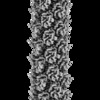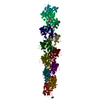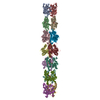+ Open data
Open data
- Basic information
Basic information
| Entry | Database: EMDB / ID: EMD-21578 | |||||||||
|---|---|---|---|---|---|---|---|---|---|---|
| Title | Cryo-EM of the Pyrobaculum arsenaticum pilus | |||||||||
 Map data Map data | cryo-EM of the P. arsenaticum pilus | |||||||||
 Sample Sample |
| |||||||||
 Keywords Keywords | helical symmetry / archaeal pilus / Type IV pilus / PROTEIN FIBRIL | |||||||||
| Function / homology | membrane / Class III signal peptide-containing protein Function and homology information Function and homology information | |||||||||
| Biological species |   Pyrobaculum arsenaticum (archaea) Pyrobaculum arsenaticum (archaea) | |||||||||
| Method | helical reconstruction / cryo EM / Resolution: 3.8 Å | |||||||||
 Authors Authors | Wang F / Baquero DP | |||||||||
| Funding support |  United States, 1 items United States, 1 items
| |||||||||
 Citation Citation |  Journal: Nat Commun / Year: 2020 Journal: Nat Commun / Year: 2020Title: The structures of two archaeal type IV pili illuminate evolutionary relationships. Authors: Fengbin Wang / Diana P Baquero / Zhangli Su / Leticia C Beltran / David Prangishvili / Mart Krupovic / Edward H Egelman /   Abstract: We have determined the cryo-electron microscopic (cryo-EM) structures of two archaeal type IV pili (T4P), from Pyrobaculum arsenaticum and Saccharolobus solfataricus, at 3.8 Å and 3.4 Å ...We have determined the cryo-electron microscopic (cryo-EM) structures of two archaeal type IV pili (T4P), from Pyrobaculum arsenaticum and Saccharolobus solfataricus, at 3.8 Å and 3.4 Å resolution, respectively. This triples the number of high resolution archaeal T4P structures, and allows us to pinpoint the evolutionary divergence of bacterial T4P, archaeal T4P and archaeal flagellar filaments. We suggest that extensive glycosylation previously observed in T4P of Sulfolobus islandicus is a response to an acidic environment, as at even higher temperatures in a neutral environment much less glycosylation is present for Pyrobaculum than for Sulfolobus and Saccharolobus pili. Consequently, the Pyrobaculum filaments do not display the remarkable stability of the Sulfolobus filaments in vitro. We identify the Saccharolobus and Pyrobaculum T4P as host receptors recognized by rudivirus SSRV1 and tristromavirus PFV2, respectively. Our results illuminate the evolutionary relationships among bacterial and archaeal T4P filaments and provide insights into archaeal virus-host interactions. | |||||||||
| History |
|
- Structure visualization
Structure visualization
| Movie |
 Movie viewer Movie viewer |
|---|---|
| Structure viewer | EM map:  SurfView SurfView Molmil Molmil Jmol/JSmol Jmol/JSmol |
| Supplemental images |
- Downloads & links
Downloads & links
-EMDB archive
| Map data |  emd_21578.map.gz emd_21578.map.gz | 70.1 MB |  EMDB map data format EMDB map data format | |
|---|---|---|---|---|
| Header (meta data) |  emd-21578-v30.xml emd-21578-v30.xml emd-21578.xml emd-21578.xml | 9.2 KB 9.2 KB | Display Display |  EMDB header EMDB header |
| Images |  emd_21578.png emd_21578.png | 111.9 KB | ||
| Filedesc metadata |  emd-21578.cif.gz emd-21578.cif.gz | 4.7 KB | ||
| Archive directory |  http://ftp.pdbj.org/pub/emdb/structures/EMD-21578 http://ftp.pdbj.org/pub/emdb/structures/EMD-21578 ftp://ftp.pdbj.org/pub/emdb/structures/EMD-21578 ftp://ftp.pdbj.org/pub/emdb/structures/EMD-21578 | HTTPS FTP |
-Validation report
| Summary document |  emd_21578_validation.pdf.gz emd_21578_validation.pdf.gz | 432.7 KB | Display |  EMDB validaton report EMDB validaton report |
|---|---|---|---|---|
| Full document |  emd_21578_full_validation.pdf.gz emd_21578_full_validation.pdf.gz | 432.3 KB | Display | |
| Data in XML |  emd_21578_validation.xml.gz emd_21578_validation.xml.gz | 6.7 KB | Display | |
| Data in CIF |  emd_21578_validation.cif.gz emd_21578_validation.cif.gz | 7.7 KB | Display | |
| Arichive directory |  https://ftp.pdbj.org/pub/emdb/validation_reports/EMD-21578 https://ftp.pdbj.org/pub/emdb/validation_reports/EMD-21578 ftp://ftp.pdbj.org/pub/emdb/validation_reports/EMD-21578 ftp://ftp.pdbj.org/pub/emdb/validation_reports/EMD-21578 | HTTPS FTP |
-Related structure data
| Related structure data |  6w8uMC  6w8xC M: atomic model generated by this map C: citing same article ( |
|---|---|
| Similar structure data |
- Links
Links
| EMDB pages |  EMDB (EBI/PDBe) / EMDB (EBI/PDBe) /  EMDataResource EMDataResource |
|---|
- Map
Map
| File |  Download / File: emd_21578.map.gz / Format: CCP4 / Size: 125 MB / Type: IMAGE STORED AS FLOATING POINT NUMBER (4 BYTES) Download / File: emd_21578.map.gz / Format: CCP4 / Size: 125 MB / Type: IMAGE STORED AS FLOATING POINT NUMBER (4 BYTES) | ||||||||||||||||||||||||||||||||||||||||||||||||||||||||||||
|---|---|---|---|---|---|---|---|---|---|---|---|---|---|---|---|---|---|---|---|---|---|---|---|---|---|---|---|---|---|---|---|---|---|---|---|---|---|---|---|---|---|---|---|---|---|---|---|---|---|---|---|---|---|---|---|---|---|---|---|---|---|
| Annotation | cryo-EM of the P. arsenaticum pilus | ||||||||||||||||||||||||||||||||||||||||||||||||||||||||||||
| Projections & slices | Image control
Images are generated by Spider. | ||||||||||||||||||||||||||||||||||||||||||||||||||||||||||||
| Voxel size | X=Y=Z: 1.08 Å | ||||||||||||||||||||||||||||||||||||||||||||||||||||||||||||
| Density |
| ||||||||||||||||||||||||||||||||||||||||||||||||||||||||||||
| Symmetry | Space group: 1 | ||||||||||||||||||||||||||||||||||||||||||||||||||||||||||||
| Details | EMDB XML:
CCP4 map header:
| ||||||||||||||||||||||||||||||||||||||||||||||||||||||||||||
-Supplemental data
- Sample components
Sample components
-Entire : Pyrobaculum arsenaticum pili
| Entire | Name: Pyrobaculum arsenaticum pili |
|---|---|
| Components |
|
-Supramolecule #1: Pyrobaculum arsenaticum pili
| Supramolecule | Name: Pyrobaculum arsenaticum pili / type: complex / ID: 1 / Parent: 0 / Macromolecule list: all |
|---|---|
| Source (natural) | Organism:   Pyrobaculum arsenaticum (archaea) Pyrobaculum arsenaticum (archaea) |
-Macromolecule #1: pilin
| Macromolecule | Name: pilin / type: protein_or_peptide / ID: 1 / Number of copies: 41 / Enantiomer: LEVO |
|---|---|
| Source (natural) | Organism:   Pyrobaculum arsenaticum (archaea) Pyrobaculum arsenaticum (archaea) |
| Molecular weight | Theoretical: 14.49064 KDa |
| Sequence | String: MTSLEIAIIV AIVLVIAIAV GWYLYTTFAA AGQQTGLTAT KATIYVTKDG NVYLNVTLVP QGAAQVAISS IEVAGVSIPC TSSNLVKAP GEYVIELSSV SVSVGQVLTG RIVLASGAIS PFTATVVAAD HVPSTENKLC SSQ UniProtKB: Class III signal peptide-containing protein |
-Experimental details
-Structure determination
| Method | cryo EM |
|---|---|
 Processing Processing | helical reconstruction |
| Aggregation state | filament |
- Sample preparation
Sample preparation
| Buffer | pH: 6 |
|---|---|
| Grid | Details: unspecified |
| Vitrification | Cryogen name: ETHANE / Chamber humidity: 90 % |
- Electron microscopy
Electron microscopy
| Microscope | FEI TITAN KRIOS |
|---|---|
| Image recording | Film or detector model: GATAN K3 (6k x 4k) / Average exposure time: 2.0 sec. / Average electron dose: 44.0 e/Å2 |
| Electron beam | Acceleration voltage: 300 kV / Electron source:  FIELD EMISSION GUN FIELD EMISSION GUN |
| Electron optics | Illumination mode: FLOOD BEAM / Imaging mode: BRIGHT FIELD |
| Experimental equipment |  Model: Titan Krios / Image courtesy: FEI Company |
- Image processing
Image processing
| Final reconstruction | Applied symmetry - Helical parameters - Δz: 5.26051 Å Applied symmetry - Helical parameters - Δ&Phi: 101.691 ° Applied symmetry - Helical parameters - Axial symmetry: C1 (asymmetric) Resolution.type: BY AUTHOR / Resolution: 3.8 Å / Resolution method: OTHER / Details: MODEL:MAP FSC, D99, MAP:MAP FSC / Number images used: 210341 |
|---|---|
| Startup model | Type of model: OTHER Details: averaged cylinder using all segments, with random azimuthal angles |
| Final angle assignment | Type: NOT APPLICABLE |
 Movie
Movie Controller
Controller












 Z (Sec.)
Z (Sec.) Y (Row.)
Y (Row.) X (Col.)
X (Col.)





















